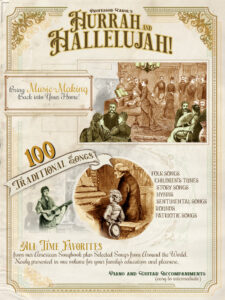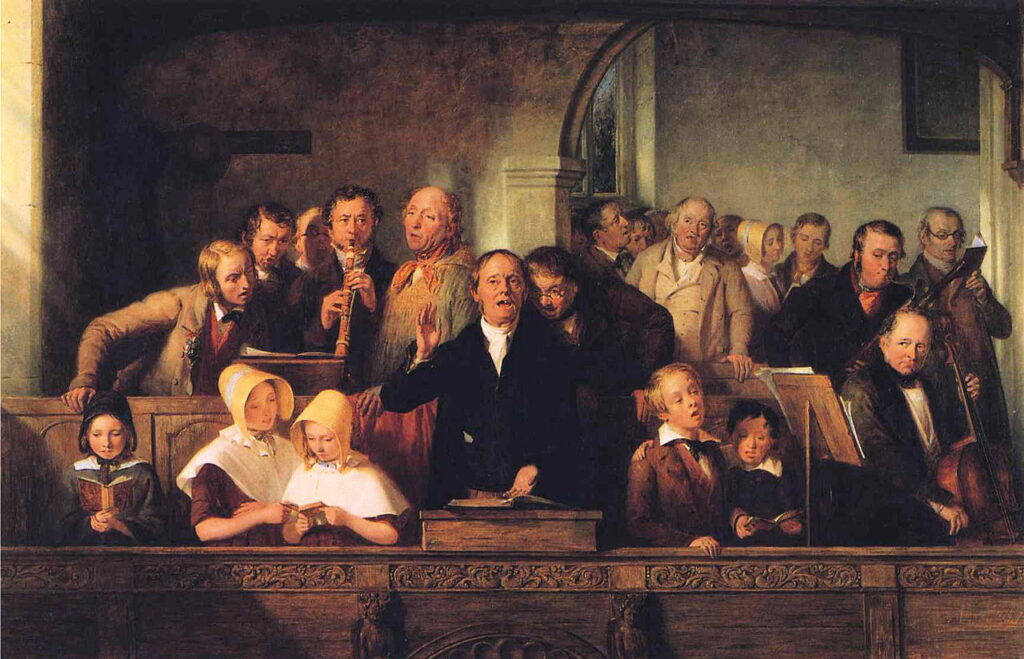 “It’s such a nice songbook. We had been looking to find something just like it. But how do we use it?”
“It’s such a nice songbook. We had been looking to find something just like it. But how do we use it?”
Now there’s a good question. When we spent the “spring shutdown” creating Hurrah and Hallelujah—a volume of songs dedicated to restoring our heritage of song—the question of “how to use it” did not cross my mind. Both Hank and I were raised in atmospheres where songs burst forth (very different types of songs in some cases, but songs nonetheless).
Today, in our fractured, techno-obsessed culture, “songs” have become links on a screen for too many kids enwrapped in earbuds. The very idea of songs resounding in the air as a regular, pleasurable, and sustaining part of daily life seems as out-of-date as the buggy whip.
So what are ways for families to proceed, especially those for whom a vital engagement with song-tradition is new? How do we make sure “learning songs” does not become yet another task in a schedule already packed with tasks and duties?
My first suggestion is to remember that we used to encounter songs regularly, in natural settings, be it during a family sing-along around the pump organ, in the backyard when neighbors bring guitars and harmonicas over to while away a Saturday evening, around the campfire or at community suppers, on the Town Green during patriotic festivals, or, for that matter, in church where real singing and acoustic music-making once dominated.

We acknowledge that it’s hard to replicate those dynamics. So, instead, try make a few selections from the songbook that you, your children, or your students do not know. Then, turn to the stunning resources brought us by recordings and online sites. We have literally a bouquet of performances available to us today that, in many cases, are free, too.
Using the well-honed pedagogy that repeated hearings are the best way to teach music, choose a variety of performances rich in contrasts: renditions by polished artists like Bing Crosby, Perry Como, Fred Astaire; vibrant performances by folk musicians like Pete Seeger, Peter, Paul, and Mary, Burl Ives, the Kingston Trio; versions cast in Country-Western, Bluegrass, or Roy-Rogers’ Cowboy Style; lively, magnificent renderings by barbershop quartets and large choral ensembles (such as the Mormon Tabernacle Choir). Don’t forget to look for purely instrumental renditions too.
And finally, and importantly, seek out performances of these songs by some of the operatic stars, particularly singers like Thomas Hampson and Renée Fleming, who have made songs from our American heritage a particular priority in their concerts and recordings.
If you are able to do even a portion of this, you will perk up the ears of your young listeners, challenge their perceptions, and very likely get them interested in those songs. Then, you can set them off on a quest to find even more performances, or to try to replicate some of these contrasting styles themselves as they sing. Whether they like the song ultimately or not does not matter. What matters is that they see the currency of this music that allows it both to survive for decades and to remain vital to a wide swath of talented musicians.
Students, particularly older ones, may enjoy a bit of sleuthing by investigating the sources and backgrounds of these songs. Were they popularized during significant political or military events in our Colonial days? Are they reflective of social movements in 19th-century history? Do they come from musical shows that sparkled with excitement in the early 20th century? Who sang them? Who wrote them? (Our songbook Hurrah and Hallelujah offers you a head start on this with some historical notes on each song.)
You may even try presenting a new song first only on paper (via the lyrics) and see how much how a student can decipher, based on the words, to place it historically or culturally. Think how a good cook can smell the essence (text) of something and declare which herbs and spices make up the recipe, even before tasting the broth (hearing the melodies).
Remember: at the root of song repertoire lies the words. Songs are poems set to music. The aesthetic and historical ramifications of this statement can be pondered endlessly, and have been in many a scholarly writing. Such musings, though, are not our first concern when presenting the heritage of song to the next generation. We want kids to taste, smell, see, and feel this music. We hope they can laugh or cry along with it. And we wish for the songs to move into the hearts and minds of each new generation so as to inspire, comfort, amuse, instruct, and edify them in own lives.
Give my initial suggestion a try. Find some vivid and contrasting performances and see what happens. Perhaps some of you will even comment about which songs you picked, what performances you chose, and the responses your kids had to the experience.




Thanks Carol! I had this question too, but what you have suggested is kind of what we did organically as a family when we started to use the book this year in our homeschool day. I started by using Spotify and making a play list of our “morning time songs”, different versions like ones that were particularly good and/or ones that were simple so that we could learn the song. (I hadn’t thought of all the different types you mentioned, so thanks for those suggestions!) We chose at least 3 different versions to listen to first, to compare. My son is a good piano player and he sometimes helps us pick out the melody, especially when we need to go slow on a tricky part, but mostly we just sit or stand and only sing around the piano. We decided just to start from the first song in the book and add a song a week until we learn them all. That became too overwhelming quickly once we had learn 5 or 6 songs, so now the goal is to add 1 song a month and at least once a week we sing the ones we’ve already learned so we don’t forget them. It’s been so fun and has been such an added blessing to our week. Thank you for your wonderful songbook and your suggestions here on how to use it!
I am so blessed that I could hand the book to my (now) 16yo and she just started playing and singing all the day. She loves it … her Danny Boy is just lovely Thanks, Carol.